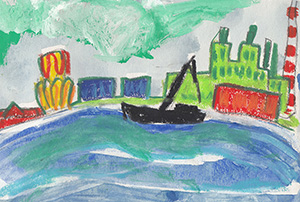 The Russian port of Murmansk is the biggest portcity in the Arctic region; it is not an old port; it was founded in the First World War, more than a hundred years ago.
The Russian port of Murmansk is the biggest portcity in the Arctic region; it is not an old port; it was founded in the First World War, more than a hundred years ago.
Russia has an enormously long coastline, measuring more than 37,000 kilometers, and throughout its history has expanded in all directions towards seas and oceans in order to trade products through ports. Russia has ports on the Black Sea and the Caspian Sea, on the Pacific Ocean, on the Baltic Sea, and through its ally Syria it is trying to gain access to the Mediterranean. The Arctic region in Northern Russia, Siberia and the North Pole is becoming increasingly important to Russia. That contains a lot of oil and gas, coal and iron, copper, nickel and other minerals. Russia, Denmark, Canada and the United States all make claims to the Arctic. Russia is doing everything it can to explore these areas; drilling rigs, pipelines, factories, infrastructure and ports are being built on a large scale, such as at Varandey, Vitino, Sabetta, Dikson and Iqaluit and the somewhat longer existing Dudinka. The seaport of Arkhangelsk was already used by Vikings in the Middle Ages, but it is not ice-free, like Murmansk. Arctic ports are growing fast. More and more ships are sailing across the Arctic Ocean north of Siberia, which is less frozen due to climate change. This route greatly shortens the trip to China.
Moermank has an important role in this Arctic development. The port benefits from the warm Gulf Stream of the North Atlantic Ocean. The city is located on a fjord, Kola Bay, of the Barents Sea, on the Kola Peninsula, above the Arctic Circle, more than a hundred kilometers from the border with Norway and 180 kilometers from the border with Finland. The name probably comes from the word oerman, the Russian name for Normans. The site was visited by Vikings in the Middle Ages.
During the First World War, in which Germany fought against Russia, England, France and other allies, the Russian port of Saint Petersburg on the Bothnian Sea was blockaded by the Germans, en so useless for Russia. That is why in 1916 the Russians built a port in the north, Murmansk, with a railway to St. Petersburg. The Allies: England, France, and other countries brought military equipment to Murmansk to assist Russia. But in 1917 the communists, led by Vladimir Lenin, seized power in Russia. Instead of Germany, the Allies now saw the Russian communists as their great opponents, especially when peace with Germany was signed in 1918 with the Treaty of Versailles. The Allies: British, American, French, and Italian troops occupied Murmansk and its environs, and areas of Siberia. But they lost out to the communist troops of the Red Army, and withdrew disillusioned at the end of 1919. Russian communism triumphed.
During the Second World War, the city again received help from the Allies; military equipment and other goods were brought to Murmansk in convoys. From Finland, the Germans attacked Murmansk; the city was destroyed but the Germans did not get their hands on the city and the vital railway line, due to fierce opposition. Murmansk was therefore given the status of Hero City.
After the war, Russian naval ships, submarines and nuclear icebreakers were stationed in Murmansk. The commercial port mainly exports coal, oil, gas, iron, nickel, apatite, and construction materials.
The city has around 300,000 inhabitants. There are several museums and hotels.
Winters are long and dark; you can sometimes see the green Northern Lights. There is even no sun at all between the beginning of December and mid-January. In the summer there is a short period when it is light day and night.




